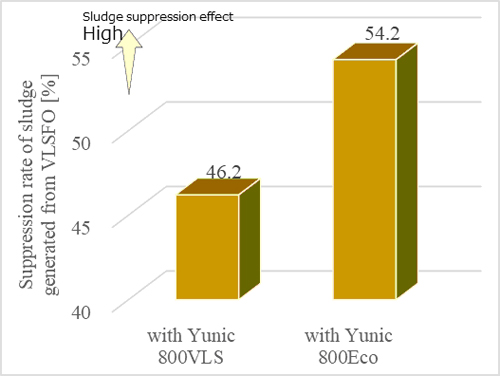NIPPON YUKA KOGYO >> Sludge Dispersant
Sludge Dispersant
Product name |
Application |
Effect |
Package |
Yunic 800Eco |
Sludge inhibition and dispersion, |
Suppresses sludge caused by poor mixing stability of VLSFO (0.50% sulfur) more strongly compare than 800VLS. As additional performance, it can be expected to reduce Fuel Oil Consumption Ratio (FOCR: g/kwh : about 1.0 % of by combustion improvement) and CO2 and improve the exhaust gas composition |
18L CAN |
Yunic 555D |
Sludge inhibition and dispersion Standard dosing rate: 1/8000 |
Suppress the occurrence of asphaltene sludge due to long-term storage, heating, and mixture of heavy fuel oil. |
18L CAN |
VLSFO may suppress sludge (caused by asphaltene and paraffin (wax)) if the compatibility is poor. As with high sulfur fuel oil, the generated sludge needs to be suppressed more strongly to prevent problems, such as sludge deposition in FO tank, FO strainer clogging and purifier malfunction etc.
There is also a necessity for more efficient use of fuel oil due to the global environmental loading reduction.
Yunic 800Eco not only effectively suppresses sludge generated from VLSFO to prevent sludge troubles due to deterioration of stability and compatibility, but also contributes to CO2 and fuel efficiency reduction by improving combustion at the same time.
✓ The FOC reduction effect by improving combustion (*1) is up to about 1.0% (*2).
✓ Furthermore, the sludge suppression performance has been enhanced (*3) compared to the conventional product Yunic 800VLS.
(*1) Actual test by the onshore experimental marine two-stroke engine
(*2) Although it depends on the properties of VLSFO and its ignitability/combustibility.
(*3) Approx. 20% improvement compared to Yunic 800VLS (lab evaluation with actual VLSFO)
The standard dosing rate for regular use is 1/8000 of VLSFO.
It can be effectively mixed with VLSFO by adding it to the FO Storage tank before bunkering in advance.
Adjust the dosing rate between 1/5000~1/10000 depending on the condition of the FO strainer and purifier.
If the stability or compatibility of VLSFO is found to be poor during bunkering or switching, please increase the dosing rate to 1/2000.

Test results by the onshore experimental marine two-stroke engine (FOC reduction effect: up to about 1.0%)

Sludge suppression effect using VLSFO (average of 50 or more cases) (Improved by about 20% compared to conventional products)
It is possible to check the compatibility (stability) of a heavy fuel oil including VLSFO (Commingled VLSFOs, VLSFO alone, and compatibility against heating and long-term storage) by the "Fuel oil spot test (basic operation is based on ASTM D4740)" in our product "Oil tester YT series".
If the Spot test result "Evaluation 3~6", it is confirmed that the compatibility (stability) is poor, we recommend to dose Yunic 800Eco as there will be a possibility of sludge formation.
We provide technical service advice for spot test judgment and analysis of various fuel oils including VLSFO. Please feel free to contact us for further information.
C heavy oil contains a component called asphaltene. It is not soluble in paraffinic hydrocarbons (an oil that is made of hydrogen saturated bonding to carbon), which is the main component of C heavy oil. In heavy oil, asphaltene is dispersed because it is covered by substance with an intermediate property between asphaltene and paraffinic hydrocarbon. However, when heavy oil is heated or mixed with other type of oil, the covering substance will be removed and asphaltene will be precipitated from heavy oil and settle as sludge.
* Definition of asphaltene: Substance that is soluble in benzene but insoluble in n- heptanes.

* Porphyrin on the right of the above figure is the active central substance of hemoglobin in the blood of animals and chlorophyll in plants. One of the reasons that petroleum is said to be originated from plants and animals is that porphyrin is found in petroleum. M (metal) that is surrounded by 4 Ns (nitrogen) is iron in hemoglobin or magnesium in chlorophyll, and sometimes it is vanadium in heavy oil. Vanadium is a metal with a low melting point and is the reason of combustion failure caused by heavy oil.
Component of Yunic 555D can disperse asphaltene in paraffinic hydrocarbons as an "intermediate substance". Therefore, the addition of Yunic555D can compensate for the "intermediate substance" that is lost due to heating or mixing of other oil. The prevention of asphaltene precipitation and sludge can prevent supply cut of fuel due to strainer obstruction. It can also help to keep the tank clean and improve fuel economy by using up the asphaltene without losing it as sludge.

<Fuel tank that Yunic 555D is being used>
- Ship type |
: Ocean-going container ship |
- Fuel oil |
: C heavy oil (mainly 380cSt) |
- Tank capacity |
: 900 m3 |
- Period of use |
: 7 years and 8 months |
- Tank cleaning |
: Yet to be implemented |
The average fuel efficiency improvement rate is about 3% by these synergistic effects. It has a high effect of improving fuel efficiency by burning the entire fuel efficiently.
Feel free to contact us if you are interested with Sludge Dispersant.